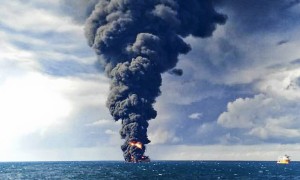 [posted by Benjamin Haas on The Guardian, January 16, 2018] The Iranian oil tanker Sanchi sank off the coast of Shanghai on Sunday, after a week of burning and sending plumes of smoke hundreds of metres into the air. Only three bodies of the 32 sailors were recovered. The ship was carrying 136,000 tons, or about 1 million barrels, of oil, that now threatens to pollute some of China’s most important fishing waters.
[posted by Benjamin Haas on The Guardian, January 16, 2018] The Iranian oil tanker Sanchi sank off the coast of Shanghai on Sunday, after a week of burning and sending plumes of smoke hundreds of metres into the air. Only three bodies of the 32 sailors were recovered. The ship was carrying 136,000 tons, or about 1 million barrels, of oil, that now threatens to pollute some of China’s most important fishing waters.
What was Sanchi transporting?
The oil tanker was carrying condensate oil, which differs considerably from the thick black oil slicks typically associated with a spill. Instead, the colourless oil is a liquid only under certain conditions and is partially soluble in water, making it much harder to separate and detect.
How much oil leaked?
Currently, it is impossible to gauge exactly how much condensate ended up in the water. Some of it burned off and some probably evaporated, but any oil still onboard when the ship sank will slowly leak out over time and be difficult to contain.
What will the impact be on the local environment?
The condensate that leaked into the water could potentially wreak havoc on local fish spawning grounds and the Sanchi sank in the migratory path of the humpback whale, according to Greenpeace.
While there will not be black beaches covered in oil, condensate is toxic when inhaled and on the skin and is described as “toxic to aquatic life with long lasting effects”.
Another concern is the fuel that was powering the Sanchi. The day after it sank, China’s State Oceanic Administration reported two oil slicks, one nearly 15km long and another about 18km long, although it is unclear if these are from the cargo or the fuel tanks.
“Given that the fuel tanks in these sorts of vessels are located close to the engine room, it is likely that the fuel tanks have remained intact since the initial collision,” said Paul Johnston, a research fellow at the University of Exeter.
“It is possible that we will see chronic low volume leakage over a period of time at the seabed. … Impact would remain relatively local.”
What could China have done differently?
There were two competing goals in dealing with the tanker: putting out the fire in an effort to rescue the crew, or allowing as much oil as possible to burn off to limit polluting the waters. In the end, there was a mixture of both.
The National Iranian Tanker Company, the firm that operated the ship, had two ships nearby and a spokesman for the company wondered why Chinese fire fighting boats were using water to douse the flames when foam would be more effective.
While the blaze was still burning the Iranian Merchant Mariners Syndicate, an industry group, voiced frustration at the lack of progress in putting out the fire, and said it was “clear that the Chinese are not cooperating enough”.
Other criticised Chinese efforts to subdue the fire, and suggested a plan that would have assumed the entire crew had no hope of rescue.
Yu Zhirong, a former deputy of the East China Sea unit of China Marine Surveillance, told business magazine Caixin the Sanchi should have been bombed or torpedoed, causing an explosion that would burn up the remaining oil and limit the amount the seeped into the ocean.
Allowing the ship to sink was described as the “worst-case scenario”.
What happens now?
China has announced it will conduct an investigation into the incident, although there is no sense when a report will emerge and how detailed it will be. Greenpeace has called on China to assess how much oil spilled into the ocean and take “appropriate containment and clean up measures”.
